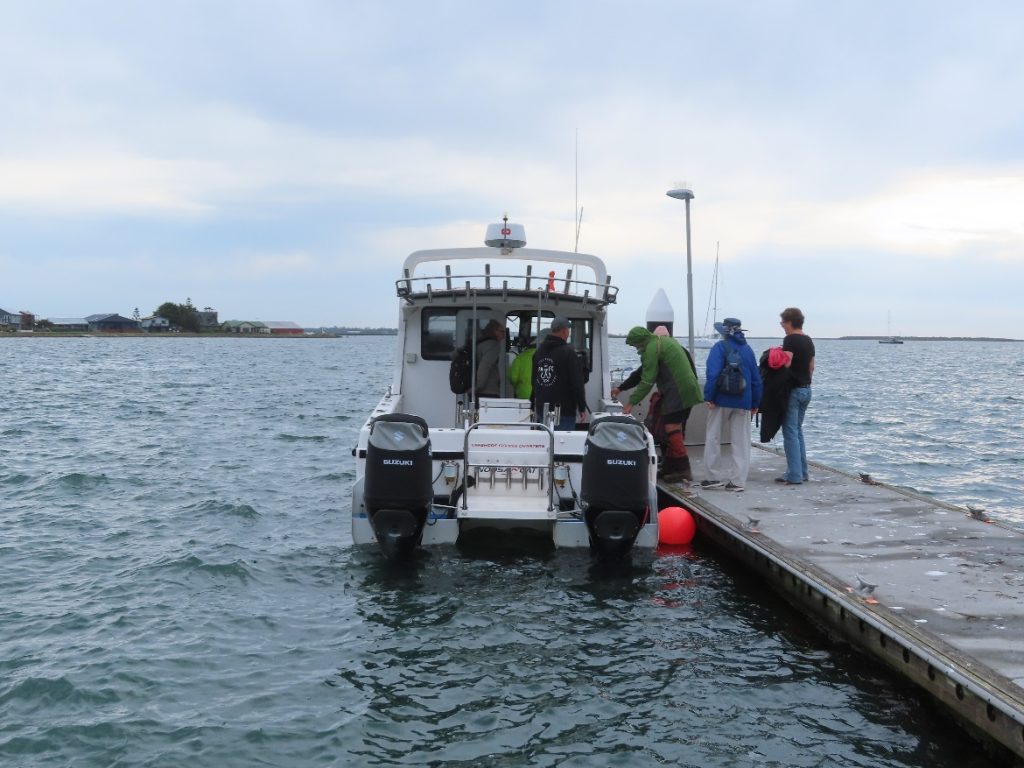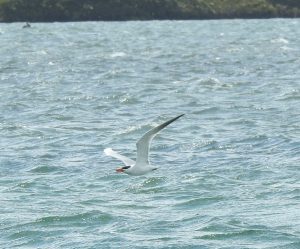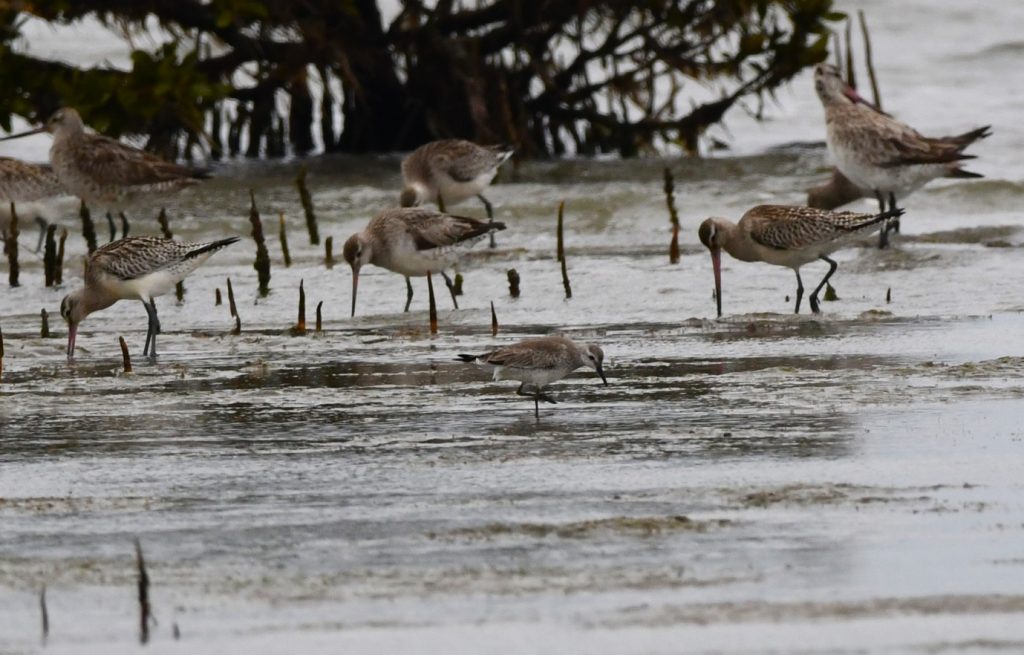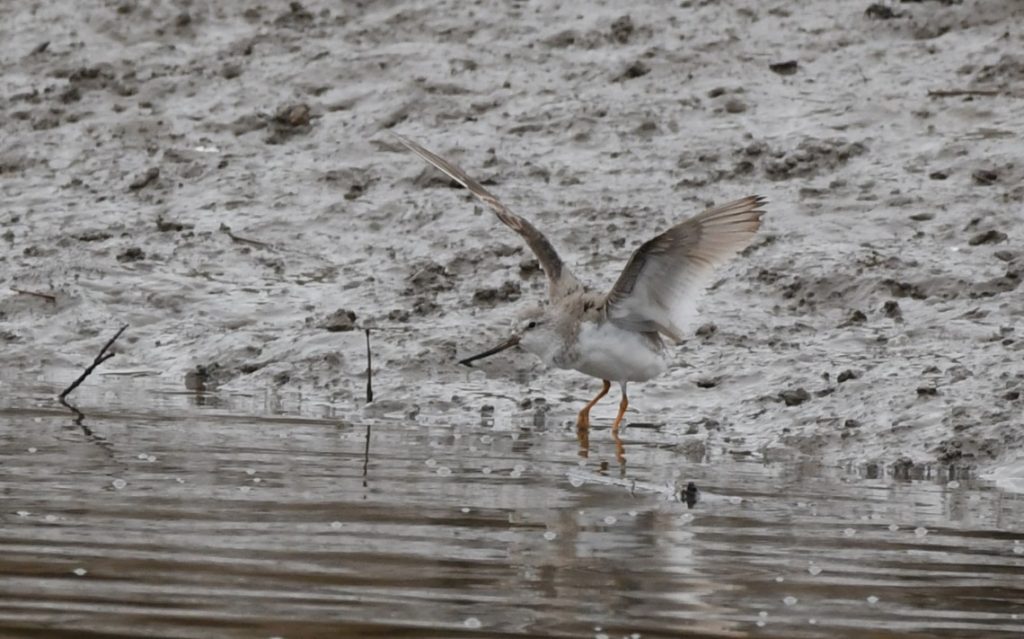SEANA Spring 2023 Camp
| Excursion 7a: Shorebirds Boat Trip No. 1 | Saturday morning |
| Leader: Tania Ireton | Facilitator: Jay Duncan |
Eight enthusiastic birdwatchers from various Field Naturalists’ Clubs, joined Brian & Belinda from “Port Albert Fishin’ Charters” on their boat, for a four-hour birding trip around the shallow, inner waters of Nooramunga Marine Park. The park comprises many, mostly small islands, inter-tidal mudflats and mangroves along the shorelines, and ever-changing sand banks depending on the tide. This area and nearby Corner Inlet, provide a very important refuge for migratory birds during the southern summer. We explored several inlets and beaches from the back of the boat and circumnavigated Sunday Island during the outing.
We were extremely fortunate to have Tania Ireton, a knowledgeable and well-known birder, lead us. She capably explained the differences between all five cormorants in this area, namely Pied, Little Pied, Black-faced, Little Black and Great Cormorant, all of which were seen. Tania also drew our attention to many other shorebirds. These included three species of tern, (Little, Caspian and Crested), Pacific Golden Plovers, Red-necked Stints, Bar-tailed Godwits, eleven Eastern Curlews and a Great Egret. Two Yellow-tailed Black Cockatoos flew over us as we returned to port and were a complete surprise. They brought our total to 35 species whilst out in the water. (See the Excursion 7b Report for a Bird List for both trips.)
Brian and Belinda happily chatted to all of us, sharing their boating skills and knowledge of the area, as well as answering our questions, about charts, tides, fishing and experiences. Nibbles added a delightful touch to the tour. Despite some initial concerns in regard to the weather, these proved unfounded and it was a worthwhile venture.
We would happily recommend this excursion to interested people.

| Excursion 7b: Shorebirds Boat Trip No. 2 | Saturday afternoon |
| Leader: David Mules | Facilitator: Jay Duncan |
On the Saturday afternoon of the SEANA camp, I joined the boat trip to observe shorebirds in Nooramunga Inlet, aiming to broaden my horizons beyond the purely botanical. Alyssa and I joined the group of seasoned birders that headed out from Port Albert. The charter boat was ably captained and crewed by Brian and Belinda, with David Mules leading the bird spotting.
As we motored slowly away from the jetty, I jotted down some birds that I recognised: Seagull (more correctly known as Silver Gull), Pelican, Welcome Swallow, Black Swan and – with a little help – Great Egret. Knowing that The List is a critical component of bird watching expeditions, I was very proud to have spotted four species before we’d even passed the Fish and Chip shop while my fellow passengers appeared to be completely unaware, chatting excitedly amongst themselves. However David later said that he’d spotted 15 species before we’d left the shore – which slightly deflated the ego.
The mood was relaxed as we chugged down the channel towards the entrance and the barrier islands, looking in all directions at islands and ripples on the water, and feeding our bird appetite with Great Cormorants, Little Pied Cormorants and Pied Oystercatchers. Whenever my identification skills felt strained, I took comfort in the graceful glide and arched necks of the Black Swans in the shallows.
As we approached the flat sands of a barrier island, a flock of greyish blobs (birds) were spotted on a sandy shore; the motor cut out, the boat slowed and we dropped anchor. As the vessel stopped, the activity onboard changed instantly from random milling about to coordinated attention. Binoculars were raised in a synchronised movement and the entire group turned as one as the boat oriented itself to the wind direction. We’d reached our goal.
The most numerous of the flock were quickly identified as Bar-tailed Godwits, and then a much smaller and less common bird was noticed. Animated discussion ensued: ‘Is it a knob?’, ‘a Curlew-Sandpiper?’ and ‘are those black things birds?’, while Alyssa snapped away with her camera and then inspected the results. One successful photo enabled a confident identification from David: ‘They’re Red-necked Stints’.
Once all the species in view had been identified, the discussion strayed from the immediate, to birds such as the Double-banded Plover. Unlike many of the other migratory species that we see that migrate to northern places such as Siberia and China, the Double-banded Plover heads across the ditch to New Zealand to breed, returning to Australia for winter. It wasn’t present for us to meet personally, so couldn’t be added to the official List, but made for interesting conversation.
Not far from the first stop were two large white birds with black beaks; we hoped for Spoonbills, which Jay said had been spotted by the morning group, but these were the Australian White Ibis. They were duly added to the list, as were two Caspian Terns that flew over, and who always sound to me like something from Narnia.
The high tide was approaching so shorebird-spotting was limited, but there was plenty to look at, and time to gaze absently at the blue, grey and green of the choppy water. Occasionally gulls winged lazily behind the boat, just in case we were going fishing like normal charter passengers – but we weren’t about to share the biscuits, cheese and kabana, so they veered off in search of better pickings.
The voyage proceeded to circumnavigate Sunday Island, the boat alternately cruising gently and bobbing along, and roaring across the water between points of interest. To make sure nobody fell overboard we were herded into the cabin for the exciting sections. The bird diversity dropped off as we headed back to the Port. But as we neared the end of our little junket we spotted some land birds – a Raven and two Galahs – flying towards the islands for their own getaway.
Jenny Wolswinkel
Consolidated Bird Lists for Saturday morning and afternoon trips:
SPECIES | PM | AM |
Black Swan | Y | Y |
| Hoary-headed Grebe | N | Y |
| Grey Teal | N | Y |
| Chestnut Teal | N | Y |
| Australian Gannet | N | Y |
| Spotted Dove | Y | N |
| Pied Oystercatcher | Y | Y |
| Sooty Oystercatcher | Y | N |
| Eastern Curlew | Y | Y |
| Bar-tailed Godwit | Y | Y |
| Red-necked Stint | Y | Y |
| Red Knot | Y | N |
| Royal Spoonbill | N | Y |
| Pacific Golden Plover | N | Y |
| Masked Lapwing | N | Y |
| Silver Gull | Y | Y |
| Pacific Gull | Y | Y |
| Caspian Tern | Y | Y |
| Little Tern | N | Y |
| Crested Tern | N | Y |
| Little Pied Cormorant | Y | Y |
| Great Cormorant | Y | Y |
| Little Black Cormorant | Y | Y |
| Black-faced Cormorant | Y | Y |
| Pelican | Y | Y |
| White-faced Heron | Y | Y |
| Great Egret | Y | Y |
| White Ibis | Y | Y |
| Grey fantail (heard) | N | Y |
| Yellow-faced Honeyeater (heard) | N | Y |
| Red Wattlebird | N | Y |
| Yellow-tailed Black Cockatoo | N | Y |
| Galah | Y | N |
| Swamp Harrier | N | Y |
| Australian Magpie | Y | Y |
| Little Raven | Y | N |
| Raven sp.(Forest?) | N | Y |
| Welcome Swallow | Y | Y |
Species counts | |
|---|---|
PM | 23 species |
AM | 33 species |
Day | 38 species |
Photos (Credit: Ian McConchie):


